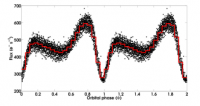 We present results from long cadence Kepler observations covering 97.6 days of the newly discovered eclipsing cataclysmic variable KIS J192748.53+444724.5/KIC 8625249. We detect deep eclipses of the accretion disk by the donor star every 3.97 hours. Additionally, the Kepler observations also cover a full outburst for this cataclysmic variable, making KIS J192748.53+444724.5 the second known eclipsing cataclysmic variable system in the Kepler field of view. We show how in quiescence a significant component associated to the hot-spot is visible preceding the eclipse, and that this component is swamped by the brightness increase during the outburst, potentially associated with the accretion disk. Furthermore we present evidence for accretion disk radius changes during the outburst by analysing the out-of-eclipse light levels and eclipse depth through each orbital cycle. We show how these parameters are linearly correlated in quiescence, and discuss how their evolution during the outburst is suggesting disk radius changes and/or radial temperature gradient variations in the disk.
We present results from long cadence Kepler observations covering 97.6 days of the newly discovered eclipsing cataclysmic variable KIS J192748.53+444724.5/KIC 8625249. We detect deep eclipses of the accretion disk by the donor star every 3.97 hours. Additionally, the Kepler observations also cover a full outburst for this cataclysmic variable, making KIS J192748.53+444724.5 the second known eclipsing cataclysmic variable system in the Kepler field of view. We show how in quiescence a significant component associated to the hot-spot is visible preceding the eclipse, and that this component is swamped by the brightness increase during the outburst, potentially associated with the accretion disk. Furthermore we present evidence for accretion disk radius changes during the outburst by analysing the out-of-eclipse light levels and eclipse depth through each orbital cycle. We show how these parameters are linearly correlated in quiescence, and discuss how their evolution during the outburst is suggesting disk radius changes and/or radial temperature gradient variations in the disk.
Authors: S. Scaringi, P.J. Groot, M. Still

